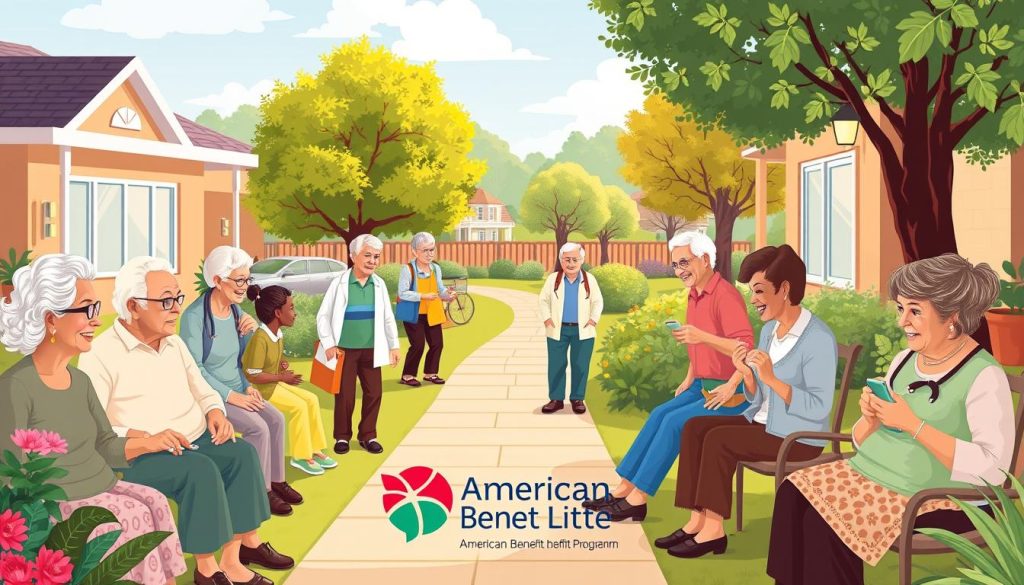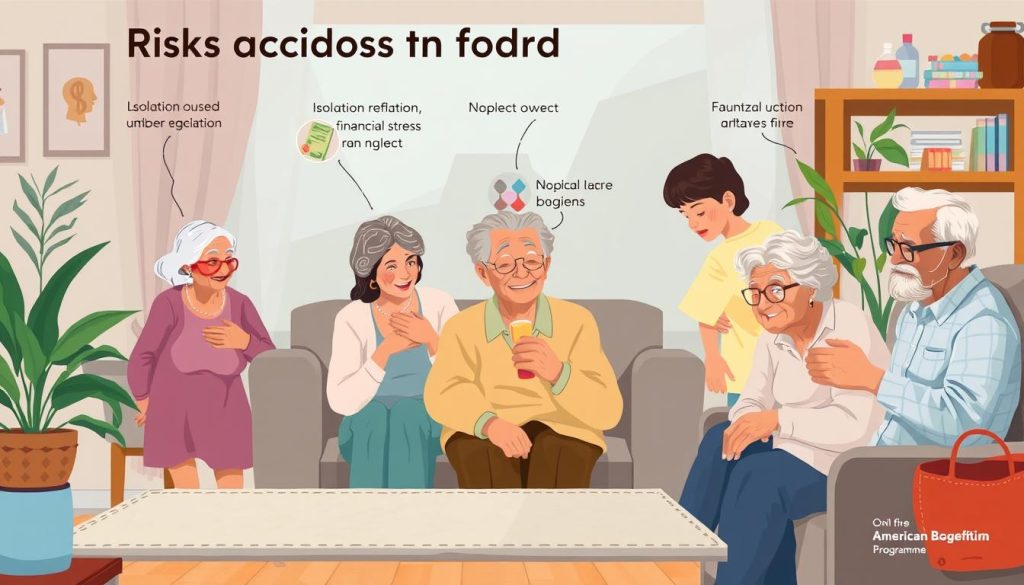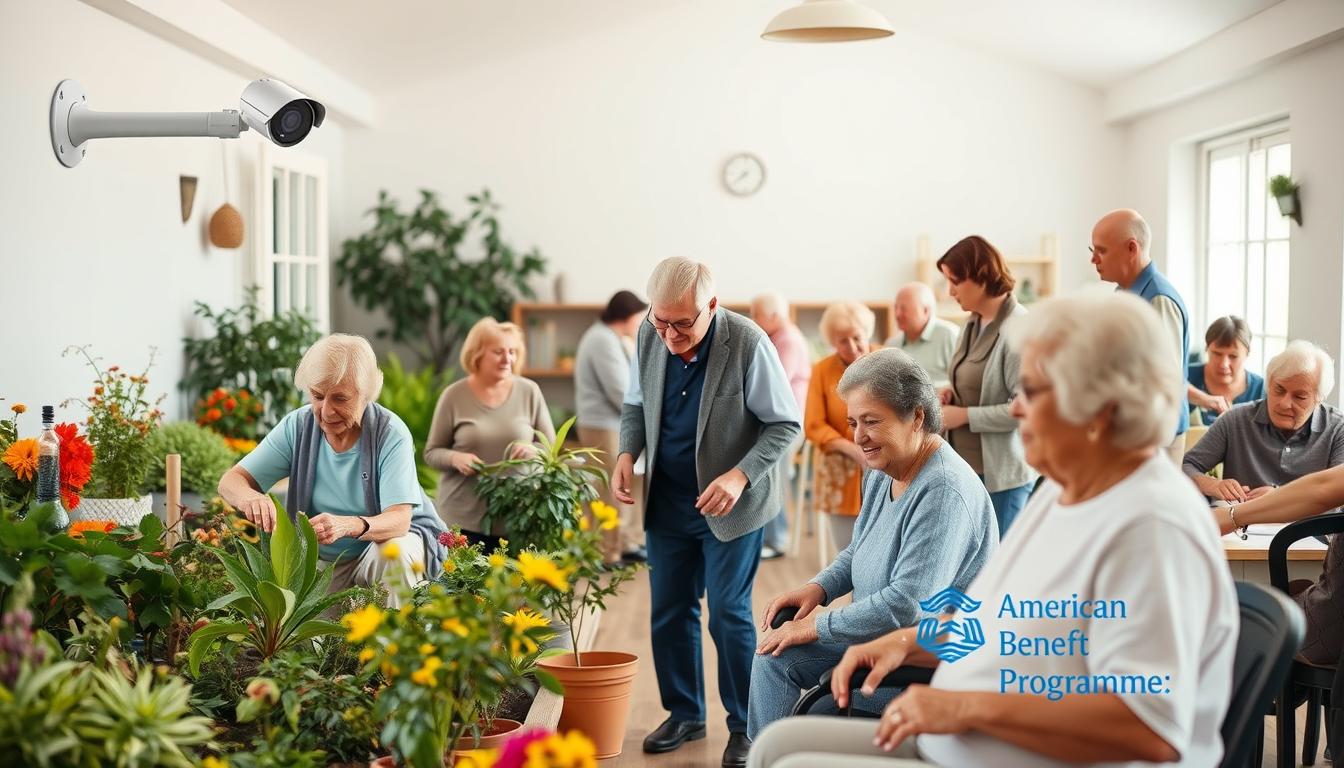Have you thought about how at risk your loved ones are in senior care places? Over 800,000 Americans live in these places. Scary facts show that 1 in 10 older than 60 face elder abuse1. Elder abuse comes in many forms like hurt, emotional harm, and stealing money2. With COVID-19 making isolation worse, it’s vital to know how to stop abuse in senior living.
This guide will go over how to keep seniors safe. We’ll focus on being aware and taking steps to protect their well-being in care homes. By learning the signs and risks of elder abuse, we can make a safe place for them. Let’s see how we can make a better world for our elders.
Key Takeaways
- Understanding the vital role of awareness in senior living abuse prevention.
- Recognizing the different forms of elder abuse and their impact on victims.
- Utilizing communication and social engagement as preventative measures.
- Identifying the signs of elder abuse to act swiftly.
- Promoting robust policies and a culture of respect in elderly care facilities.
Understanding Elder Abuse
Elder abuse harms many seniors, leading to physical and psychological damage. Yearly, many above 60 suffer abuse, neglect, or financial harm3. This includes physical, psychological, sexual abuse, and misusing money4.
Most elder abuse victims are women, but men are affected too3. Those without nearby loved ones or with health issues are more at risk3. Financial abuse often involves stealing or fraud by trusted people3.
Signs of elder abuse might be hard to spot but include injuries and poor living conditions3. Sadly, few cases get reported due to victims’ fear4.
Often, family members are the abusers, especially adult children or spouses4. So, improving elder care facility’s safety is vital.
We need to talk more in families and with caregivers. It’s key to monitor and prevent elder abuse and keep seniors safe.
The Importance of Senior Living Abuse Prevention
Keeping older adults safe in care homes is very important. Sadly, 1 in 10 seniors in the U.S. have faced abuse5. Abuse can hurt them physically and emotionally, troubling both them and their families.
It’s key to know what causes elder abuse. Things like caretaker dependence, feeling alone, and stress can make abuse more likely5. Good hiring and training can stop abuse. This is crucial because most abusers have no prior crimes6. Checking staff backgrounds and teaching them about abuse can help a lot.
Families and helpers need to spot signs of abuse and fight for better care. Going to court may help get justice and change things6. Getting the community involved and making sure seniors have friends and activities can prevent abuse.

Types of Elder Abuse
Elder care abuse comes in different forms, from physical to financial. Each type harms older adults in unique ways.
Physical Abuse
Physical abuse means hurting an elder on purpose. It covers hitting, slapping, and wrongfully using restraints. Sadly, many elders face this in places like nursing homes. A shocking 2 out of 3 staff members admitted to such actions in the past year7.
The harm from physical abuse goes beyond the body. It can deeply affect an elder’s heart and mind.
Verbal and Mental Abuse
Words and actions that cause emotional pain are verbal and mental abuse. This includes scaring, shaming, and threatening. It’s the top type of abuse elders face8.
Noticing signs is key. Emotional hurt can really harm an elder’s well-being.
Financial Abuse
Financial abuse is when someone wrongly uses an elder’s money or property. It’s taking funds without permission or tricking an elder for money. Elders report this abuse more than others7. In the U.S., 1 in 10 elders at home face some abuse8.
Knowing about financial abuse helps protect seniors from harm.
Sexual Abuse
Sexual abuse is forcing an elder into unwanted sexual actions. It’s hard to spot and often stays hidden. Teaching and awareness are key to keeping elders safe from this abuse.
Signs of Elder Abuse to Watch For
It’s important to know the signs of elder abuse. This helps family members and caregivers spot problems early. Signs can be physical, behavioral, or financial. Keeping an eye on elder care is key. This makes sure older people get the care they need.
Physical Signs
Physical signs are easy to see. Look for bruises, cuts, or burns that don’t make sense. About 1 in 10 older people are abused each year9. Many don’t tell anyone. So, staying watchful is vital.
Behavioral Changes
Changes in how elderly act can warn us. Look for them pulling away, feeling scared, or being very anxious. This could mean they’re being hurt. A study from 2014 found those over 80 are at bigger risk9. Caregivers must take these signs seriously and act fast.
Financial Irregularities
Money problems can be a clue too. Watch for sudden money issues, missing cash, or lost items. Nearly half of those with dementia face abuse or neglect9. Watching their finances can prevent fraud and theft.
Risk Factors for Elder Abuse
Old folks can face dangers due to several risk factors for elder abuse. One major problem is caregiver stress. It can lead caregivers to hurt or emotionally abuse the elderly. Especially when they are overwhelmed by the elder’s health needs10. Using drugs or alcohol is also a big warning sign of possible abuse10. Every year, about 500,000 old people are hurt or neglected in the U.S. Sadly, many cases are never reported11.
Being alone can put seniors in danger11. Those who need help with daily stuff may feel scared to talk about bad treatment. Having good people around and understanding feelings can protect them from harm10. It’s important to know that 75% of elder abuse cases are by family members. This shows how critical family ties are10.
Getting weaker or having diseases like dementia makes elders more likely to be abused11. A big study shows 69% of those who mistreat elderly folks are men. This fact underlines the role of gender in elder abuse10. Knowing these dangers helps us find ways to keep our elderly folks safe.

| Risk Factor | Description |
|---|---|
| Caregiver Stress | High stress levels can lead to abusive behavior towards seniors in care. |
| Substance Abuse | Past or current abuse of drugs or alcohol is linked to increased risk of elder abuse. |
| Social Isolation | Seniors without a support network are more vulnerable to abuse. |
| Decreased Physical Health | Health conditions like dementia increase likelihood of being targeted for abuse. |
| Family Dynamics | 75% of elder abuse cases involve family members as the abusers. |
| Emotional Intelligence | High emotional intelligence in caregivers can act as a protective factor against abuse. |
Strategies to Prevent Senior Living Abuse
It’s key to stop elder abuse to keep older people safe and respected. Acting early can cut down abuse risk.
Establish Regular Communication
Talking often with seniors helps keep an eye on their health and happiness. This can catch problems early. It also spots signs of trouble, keeping elders safe.
Encourage Social Engagement
Joining in activities helps seniors make friends and stop feeling alone. This lowers abuse risk. It also encourages them to speak up if something’s wrong.
Educate About Scams
Learning about scams can protect seniors from losing money. It teaches them to spot dangers and stay safe from financial harm12. This knowledge is a big help.
| Strategy | Purpose | Benefit |
|---|---|---|
| Regular Communication | Stay informed | Early detection of issues |
| Social Engagement | Reduce isolation | Encourages sharing experiences |
| Scam Education | Raise awareness | Prevents financial exploitation |
Senior Living Abuse Prevention: Creating a Safe Environment
To create a safe place for seniors, we need good caregivers and the right tech. Finding the perfect caregiver is key for good senior care.
Selecting the right person to care for elders involves many steps. About 1 in 10 older people face abuse, often from caregivers they trust. That’s why it’s so important to check caregivers well. This means looking at their past work, checking backgrounds, and making sure they know how to care for the elderly. By doing these things, we make places safer for seniors1314.
Selecting Appropriate Caregivers
Choosing the right caregivers for seniors matters a lot. It involves a careful process to find people we can trust. This process helps stop abuse, which sadly happens to many elderly.
Having good ways to report abuse is important for keeping seniors safe. A good choice means really checking on who we hire, looking at their history, and making sure they’ve cared for seniors well before.
Utilizing Technology for Monitoring
Using tech helps keep senior living places safe. Gadgets like medical alerts let seniors tell family or help if there’s trouble. Each year, close to 5 million older Americans get hurt by others. This shows how much we need tech to watch out for them15. Such gear protects seniors and keeps family updated on how they are.
Resources for Reporting and Assistance
Finding the right help is key to stop elder abuse and keep seniors safe. Many groups offer info and support services. They help a lot with the elder abuse issue.
Local and National Hotlines
In the U.S., there are over 2,600 local Adult Protective Services (APS) agencies16.They check on reports of elder abuse, neglect, or exploitation. This makes sure problems are fixed. People can call these hotlines for advice on how to report abuse16.The National Adult Protective Services Association helps find APS offices in each state. This makes it easier for those who need help. Also, the Federal Trade Commission and the FBI’s Internet Crime Complaint Center are important16.They identify and report frauds or scams that target older adults.
Support Groups and Advocacy Organizations
Support groups and advocacy organizations help elders and their families connect. They learn about their rights16.The National Center on Elder Abuse works to stop elder abuse. It shows that about 1 in 10 elders face abuse. Groups like the American Bar Association protect elders’ legal rights, offering advocacy and education17.Also, the International Network for the Prevention of Elder Abuse spreads info worldwide to prevent abuse, showing why it’s critical everywhere17.
| Organization | Function | Contact Information |
|---|---|---|
| National Adult Protective Services Association | Supports state APS programs and provides contact information for local offices. | Varies by state |
| National Center on Elder Abuse | Provides resources and information to combat elder abuse. | www.ncea.aoa.gov |
| American Bar Association Commission on Law and Aging | Advocates for elder rights, focusing on law and policy issues. | www.americanbar.org |
| International Network for the Prevention of Elder Abuse | Works globally to prevent elder abuse through dissemination of information. | www.inpea.net |
| Legal Services Corporation | Provides legal assistance to low-income individuals, including the elderly. | www.lsc.gov |
Conclusion
We must always work to keep our older adults safe and treated with respect in senior homes. Elder abuse is a big issue worldwide. It’s key to know the signs of abuse and how to stop it. About 1 in 6 people over 60 have faced abuse in the last year. This shows we need to act together18.
Families, those who care for others, and community folks should talk openly. And teach seniors about their rights. There’s a growing number of abuse cases, from physical harm to emotional. So, it’s urgent to have good prevention plans. This includes training staff well and checking their past19. Fighting for needed changes helps make a safe place for elders. This is key to tackling this issue.
There are resources out there, like hotlines and groups to join for help. Having the right knowledge helps us prevent abuse better. And improves elder’s lives, leading to a safer tomorrow. For tips and ways to stop elder abuse, check this useful guide.
Source Links
- Preventing Elder Abuse | SeniorLiving.org
- Elder Abuse and Neglect – HelpGuide.org
- Elder Abuse
- A Caregiver’s Guide to Understanding, Recognizing, and Preventing Elder Abuse | Maryville Nursing
- Elder Abuse Prevention – Can Elder Abuse Be Prevented?
- Abuse Prevention Programs in Senior Living & Social Services – M3 Insurance
- Types of Elder Abuse – Know the 7 Different Forms of Abuse
- NCEA | Elder Abuse
- Signs of Elder Abuse – Elder Abuse Signs and What to Look For
- Risk and Protective Factors
- Understanding the Risk Factors for Elderly Abuse
- Seven Simple Ways to Prevent Elder Abuse
- Interventions for preventing abuse in the elderly
- Tip Sheet: Preventing Elder Abuse and Neglect in Older Adults
- Elder Abuse Prevention
- How to find help responding to elder financial abuse | Consumer Financial Protection Bureau
- Resources
- Abuse of older people
- Abuse of Residents in Senior Living Facilities: How to Address It – Seif & McNamee

Leave a Reply